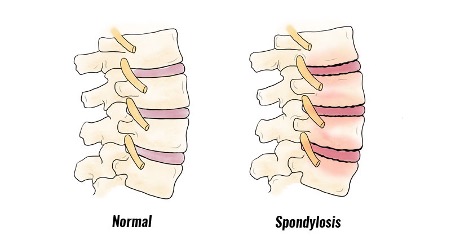
Pain In the Neck and Back Due to Wear-And-Tear or Aging
Spondylosis describes the wear and tear of joints, discs, and ligaments in the spine. Spondylosis is also known as a degeneration (or aging) of the spine. It is a common problem, seen in most people as they grow older. While spondylosis creates neck and back pain in some people, others experience no symptoms at all.
Facts And Information About Spondylosis
- Spondylosis may appear anywhere in the spine but is most common in the neck (cervical spondylosis) and low back (lumbar spondylosis), areas that are under a lot of strain.
- Spondylosis is a common condition, that worsens with age. More than 85 percent of people older than age 60 have cervical spondylosis.
- Spondylosis usually develops in people over 40 years of age, but it can affect younger people who suffer a physical strain or an injury.
Why Spondylosis Develops
For many people, spondylosis is a normal part of aging. For other people, spondylosis results from playing high-impact sports, the strain on the job, car accidents, poor posture, or smoking.
How Spondylosis Develops
Once spondylosis starts, a lot of changes are seen in a person’s spine. Much like a domino effect, as the joints start to wear down, other parts of the spine (the ligaments and backbones) also start to age and change for the worst.
Changes in the spine may include:
- Arthritic joints. The cartilage in the small facet joints found between the backbones wears down, making movement in the spine difficult and painful. It leads to grinding or popping when a person moves.
- Growth of bone spurs. As the facet joints wear down, the backbones start to rub together, causing friction. This creates bone growths, called bone spurs, that make the spine stiff and create pain when moving the neck or back.
- Stiff ligaments. Ligaments are strips of tissue that connect one bone to another bone. In the spine, ligaments can stiffen with age, making the neck and backless flexible.
- Pinched Nerves. Due to arthritic joints and bone spurs, the spaces where spinal nerves exit the spine start to shrink. This can pinch the spinal nerves, causing muscle weakness and severe pain in the neck, shoulders, arms, back, or legs.
- Pressure on the spinal cord. Although uncommon, spondylosis can create pressure on the spinal cord. This is a serious situation where a person starts to have trouble walking and loses control of their bowel or bladder.
Other problems linked to Spondylosis are disc degeneration, spinal stenosis, and scoliosis.
How A Diagnosis of Spondylosis Is Made
- A diagnosis is based on a person’s pain pattern (where they have pain in the neck or back) and on a neurological exam that looks for signs of nerve damage, such as weakness or loss of sensation.
- Imaging tests such as X-rays can show arthritic joints and bone spurs.
- Nerve conduction tests and MRIs (magnetic resonance imaging) gives more detailed information on nerve damage.
- CT (computerized tomography) scans can show changes in the bones. They are used alongside the patients’ history and the findings of the physical exam.
Treatments for Spondylosis
For cases of spondylosis that cause only mild pain and occasional stiffness, treatment is not necessary. Home remedies, rest, and over-the-counter medications are enough to control the pain.
For people who have moderate or severe pain, a number of treatments and procedures offered by a pain specialist can provide long-term relief.
Possible Treatments
- Epidurals
- Joint Injections
- Nerve Block
- Radiofrequency Neurotomy
- Platelet Rich Plasma (PRP Therapy)
- Stem Cell Therapy
- K Laser Therapy
- Prolotherapy
- Medial Branch Blocks
Precision Pain Care and Rehabilitation has two convenient locations in Richmond Hill – Queens and New Hyde Park – Long Island. Call the Richmond Hill office at (718) 215-1888, or (516) 419-4480 for the Long Island office, to arrange an appointment with our Interventional Pain Management Specialist, Dr. Jeffrey Chacko.













